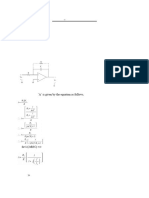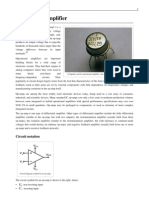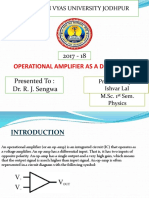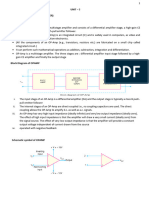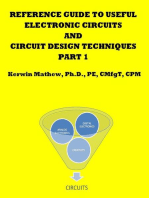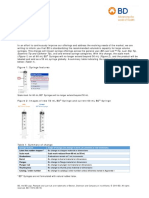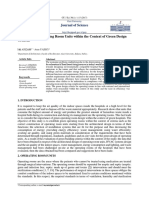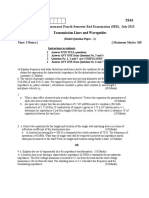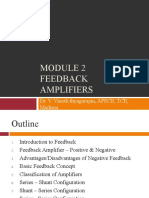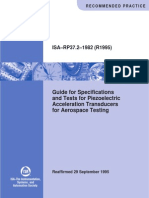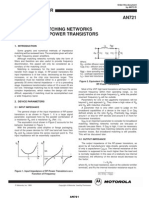Sensor Lect5
Sensor Lect5
Uploaded by
morton1472Copyright:
Available Formats
Sensor Lect5
Sensor Lect5
Uploaded by
morton1472Original Description:
Copyright
Available Formats
Share this document
Did you find this document useful?
Is this content inappropriate?
Copyright:
Available Formats
Sensor Lect5
Sensor Lect5
Uploaded by
morton1472Copyright:
Available Formats
Lecture (5)
Interface Electronic Circuits
Part: 1
Prof. Kasim M. Al-Aubidy
Philadelphia University-Jordan
AMSS-MSc Prof. Kasim Al-Aubidy 1
Interface Circuits:
An interface circuit is a signal conditioning circuit used to bring signal from the sensor
up to the format that is compatible with the load device.
The input impedance: shows by how much the
circuit loads the sensor, it is expressed by;
Example; if the input of a circuit is modeled as a parallel connection of input resistance (R) and
input capacitance (C), the complex input impedance is;
At very low frequencies, a circuit having a low input capacitance and resistance has an input
impedance, which is almost equal to the input resistance: ZR.
AMSS-MSc Prof. Kasim Al-Aubidy 2
The Output Impedance:
For voltage source sensor: the circuit is comprised of the sensor output impedance
(Zout), and the circuit input impedance (Zin).
The output signal from the sensor is represented by a voltage source (e) connected in
series with the output impedance.
For current source sensor: the current source is connected in parallel with the sensor
output impedance.
The circuit input voltage (Vin) is represented as;
AMSS-MSc Prof. Kasim Al-Aubidy 3
Importance of the input impedance:
Consider a purely resistive sensor connected to the input impedance.
The circuit’s input voltage as function of frequency (f) can be expressed by;
Assume that a 1% accuracy in the amplitude detection is required, then the maximum
stimulus frequency is;
Operational amplifiers usually have limited frequency bandwidths. There are
programmable operational amplifiers, which allow the user to control the bias
current and, therefore, the first stage frequency response. The higher the current,
the faster would be the response.
AMSS-MSc Prof. Kasim Al-Aubidy 4
Amplifiers:
Most passive sensors produce weak output signals with magnitudes on the order of
microvolts (mV) or picoamperes (pA). Therefore, an amplification of the sensor output
signals has to be made with a voltage gain up to 10,000 and a current gain up to 1
million.
The amplifiers are composed of standard building blocks, such as operational amplifiers
and various discrete components.
Operational Amplifiers:
By using OpAmps and discrete components (resistors, capacitors, inductors, etc.), you
may create an infinite number of useful circuits, such as; amplifiers, summers,
integrators, differentiators.
AMSS-MSc Prof. Kasim Al-Aubidy 5
OpAmp Properties:
Two inputs: one is inverting (-) and the other is non-inverting (+);
A high input resistance : on the order of hundreds of MΩ or even GΩ
A low output resistance: a fraction of Ω
An ability to drive capacitive loads
A low input offset voltage (eo): few mV or even µV
A low input bias current (io): few pA or even less
A very high open loop gain AOL (at least 104 and preferably over 106). The OpAmp
must be able to amplify a voltage difference (Vin) between its two inputs by a factor
of AOL;
A high common mode rejection ratio (CMRR): the amplifier suppresses the in-
phase equal magnitude input signals (common-mode signals) VCM applied to its
both inputs;
A low intrinsic noise;
A broad operating frequency range;
A low sensitivity to variations in the power supply voltage;
A high environmental stability of its own characteristics.
AMSS-MSc Prof. Kasim Al-Aubidy 6
Open Loop OpAmp:
An OPAM is very rarely used with an open loop due to;
- the high open-loop gain may result in circuit instability,
- a strong temperature drift,
- noise, etc.
Example: if the open-loop gain is 105, the input voltage drift of 10 mV would cause the
output drifts by about 1 V.
AMSS-MSc Prof. Kasim Al-Aubidy 7
Offset Voltages:
An interface circuit does not produce zero output when zero input signal is applied, due
to offset voltages and bias currents.
If the input offset voltage is still too large for the desired accuracy, it can be trimmed
out either directly at the amplifier , or in the independent offset compensation circuit.
The output offset voltage is given by;
where;
Reqv : is the equivalent resistance at the input (a combination of the sensor’s output
resistance and the input resistance of the amplifier),
eo : is the input offset voltage, and
io : is the input bias current.
To avoid offset voltages, select an amplifier with low bias current, high input resistance,
and low offset voltage. Chopper-stabilized amplifiers are especially efficient for
reduction of offset voltages.
AMSS-MSc Prof. Kasim Al-Aubidy 8
Voltage Follower:
It is a an electronic circuit that provides impedance conversion from a high to low level.
It is a current amplifier and impedance converter used for sensor interfacing.
A typical follower has;
- high Zin; high input resistance and the low input capacitance.
- low output impedances ; low output resistance, the output
capacitance makes no difference.
- voltage gain very close to unity (typically, 0.999 at lower
frequencies) and a high current gain.
Voltage follower provides a buffering function between the sensor and the load. The
following points should be considered;
1. For the current-generating sensors, the input bias current of the follower must be at
least 100 times smaller than the sensor’s current.
2. The input offset voltage must be smaller than the required LSB.
3. The temperature coefficient of the bias current and the offset voltage should not
result in errors of more than 1 LSB over an entire temperature range.
AMSS-MSc Prof. Kasim Al-Aubidy 9
Instrumentation Amplifier (IA):
An IA has two inputs and one output and is
distinguished from an OpAmp by its finite
gain (which is 100) and the availability of
both inputs for connecting to the signal
sources.
The main function of the IA is to produce an
output signal which is proportional to V;
It is important to assure high input resistances for both inputs, so that the amplifier
can be used in a true differential form.
The IA should have a high common-mode rejection ratio (CMRR); i.e. its output
signal should be insensitive to the value of V + or V- but responsive only to their
difference.
An example: IA type (INA118) from Burr-Brown/Texas Instruments, it offers low
offset voltage of 50 mV, high CMRR (110 dB), and its gain is programmed by a
single resistor.
AMSS-MSc Prof. Kasim Al-Aubidy 10
Charge Amplifier (CA):
It is a very special class of circuits, which must have extremely low bias currents. These
amplifiers are employed to convert to voltage signals from devices generate very small
charges, such as capacitive sensors.
Charge-to-voltage converter :
A capacitor (C) is connected into a feedback
network of an OpAmp. Its leakage resistance (r)
must be substantially larger than the impedance
of the capacitor at the lowest operating
frequency. A transfer function of the converter
is;
Capacitive sensors are either active or passive;
Active capacitive sensors require an excitation signal, such as microphones, capacitive
force, and pressure transducers and humidity detectors.
Passive capacitive sensors directly convert a stimulus into an electric charge or
current. Examples are the piezoelectric and pyroelectric detectors.
AMSS-MSc Prof. Kasim Al-Aubidy 11
Current generating sensor:
It is modeled by a leakage resistance (r) connected in parallel with a current generator
that has an infinitely high internal resistance.
Since r ZL then the current (io) is
useless and to minimize the error of
the current-to-voltage conversion.
The sensor generates current (i) which has two ways to outflow:
io : to the sensors leakage resistance (r),
iout:, to the interface circuit i/p impedance (ZL).
Since voltage at the inverting input is almost equal to that at the non-inverting input
(which is grounded), then the sensor operates at nearly zero voltage and its current
defines the output voltage of the OpAmp;
The advantage of the virtual ground is that the output signal does not depend on the
sensor’s capacitance.
AMSS-MSc Prof. Kasim Al-Aubidy 12
Non-inverting current to voltage converter:
It can convert and amplify the signal, however,
its speed response depends on both the sensor’s
capacitance (C) and the converting resistor
(R1). Thus, the response to a step function in a
time domain can be described by;
Note: When converting currents from such sensors, the resistor Rb may be required on
the order of tens or even hundreds of gigohms. (!!!)
AMSS-MSc Prof. Kasim Al-Aubidy 13
Light-to-Voltage Converters:
They are based on combination of photosensors and current-to-voltage converter
circuits.
Three types of a photosensor are available:
1. Photodiode,
2. Phototransistor, and
3. Photoresistor.
The difference between a photodiode and a phototransistor is in construction of the
semiconductor chip. A photodiode has one p-n junction, while a phototransistor has
two junctions. The base current is a photo-induced current that is multiplied by the
transistor’s β to produce the collector current. Thus, a phototransistor is equivalent to a
photodiode with a built-in current amplifier.
AMSS-MSc Prof. Kasim Al-Aubidy 14
Photodiode operation:
The current generator generates a photocurrent proportional to the photon flux.
This current flows in the direction from the cathode (-) to the anode (+) of the
photodiode.
A photodiode can be used in voltaic or current modes;
Voltaic mode;
The photodiode is connected to a very high resistor (107–109 Ω) and a good voltage
amplifier.
The diode will work like a battery with voltage proportional to the light intensity. This
voltage is the result of a photocurrent ip passing through the internal junction resistance
(Rj).
Current mode;
The photodiode is virtually shorted (a voltage across the diode is zero) and current (i p)
is drawn to the current-to-voltage converter as described below.
This node is more popular, especially for applications where a high-speed response is
required.
AMSS-MSc Prof. Kasim Al-Aubidy 15
A zero-biased photodiode with a current-to-voltage converter:
VOUT = ipR
R 100 MΩ
Light-to-voltage converted with a photo-transistor:
It is more sensitive to light
but with higher nonlinearity
at stronger Irradiances.
AMSS-MSc Prof. Kasim Al-Aubidy 16
Excitation Circuits:
External power is required for operation of the active sensors, such as; temperature
sensors (thermistors and RTDs), pressure sensors (piezoresistive and capacitive).
The power may be delivered to a sensor in different forms;
- a constant voltage, a constant current, and sinusoidal or pulsing currents,
- it may be delivered in the form of light or ionizing radiation.
It is imperative to generate the signal with such accuracy that the overall performance
of the sensing system is not degraded.
AMSS-MSc Prof. Kasim Al-Aubidy 17
Voltage-to-Frequency Converter (VFC):
The output frequency of the VFC is proportional to the average value of the input
voltage.
When acting as an A/D converter, the V/F converter is coupled to n-bit counter, which
is clocked with the required sampling rate. For example, if a full-scale frequency of the
converter is 32 kHz, and the counter is clocked 8 times per second, the highest number
of pulses, which can be accumulated every counting cycle is 4,000, which means 12-bit
resolution.
The time required to convert an analog voltage into a digital number is related to the
full-scale frequency of the VFC and the required resolution. The VFC output (fout)
is proportional to the input voltage (Vin);
where; fFS and VFS are the full-scale frequency and input voltage, respectively.
For a given linear converter, ratio fFS/VFS= G is constant and is called a conversion
factor, then
AMSS-MSc Prof. Kasim Al-Aubidy 18
VFC Types:
The most popular types of the VFC are the multi-vibrator and the charge-balance
circuit.
A multi-vibrator VFC: employs a free-running square-wave oscillator where charge-
discharge currents of a timing capacitor are controlled by the input signal.
The capacitor (C) is charged for a half of period
through transistor U1 by the current (ia). During
the second half of the timing period, it is
discharged by the current (ib) through transistor
U2. Since currents (ia & ib) are controlled by the
input signal, the capacitor charging and
discharging slopes vary accordingly, thus
changing the output frequency.
AMSS-MSc Prof. Kasim Al-Aubidy 19
Charge-Balance VFC;
It employs an analog integrator and a voltage comparator. This circuit has advantages;
high speed, high linearity, and good noise rejection.
Operation: The integrator generates a saw-tooth voltage that results in a transient at the
comparator’s output. That transient enables a one-shot generator, which produces a
square pulse of a fixed duration (tos).
AMSS-MSc Prof. Kasim Al-Aubidy 20
Successive Approximation ADC:
AMSS-MSc Prof. Kasim Al-Aubidy 21
References:
1. Jacob Fraden, “Handbook of Modern Sensors; Physics, Design, and Applications”, Fourth Edition,
Springer Press 2010.
2. Kelley CT (2003) Solving nonlinear equations with Newton’s method, No. 1 Fundamentals of
Algorithms. SIAM, Philadelphia, PA
3. ISO guide to the expression of uncertainty in measurements (1993) International Organization for
Standardization, Geneva, Switzerland
4. Taylor BN, Kuyatt CE (1994) Guidelines for evaluation and expressing the uncertainty of NIST
measurement results. NIST Technical Note 1297. US Government Printing Office, Washington DC
5. Widlar RJ (1980) Working with high impedance Op Amps, AN24, Linear Application Handbook.
National Semiconductor
6. Sheingold DH (ed) (1986) Analog-Digital Conversion Handbook. 3rd ed., Prentice-Hall, Englewood
Cliffs, NJ.
AMSS-MSc Prof. Kasim Al-Aubidy 22
You might also like
- FGI Patient Handling and Mobility Assessments 191008Document476 pagesFGI Patient Handling and Mobility Assessments 191008morton1472100% (2)
- Bently Reverse Rotation ProtectionDocument6 pagesBently Reverse Rotation ProtectionDipti BhanjaNo ratings yet
- Interface Sensor Circuit NotesDocument22 pagesInterface Sensor Circuit NotesMatovu HerbertNo ratings yet
- Iia Module Iii PDFDocument13 pagesIia Module Iii PDFgayathri vishnuNo ratings yet
- Unit 2: Definition of IcDocument26 pagesUnit 2: Definition of Icsai kiranNo ratings yet
- Analog Circuits-II Answer KeyDocument30 pagesAnalog Circuits-II Answer KeyreneeshczNo ratings yet
- Input Impedance of An Amplifier and How To Calculate ItDocument18 pagesInput Impedance of An Amplifier and How To Calculate ItManoj SinghNo ratings yet
- Module 1Document13 pagesModule 1suresh mariappanNo ratings yet
- Unit 05 EtcDocument8 pagesUnit 05 EtcRohit GhavateNo ratings yet
- Final Report On Op-Amp To OTA ConversionDocument41 pagesFinal Report On Op-Amp To OTA ConversionAman VatsNo ratings yet
- Exp No8Document9 pagesExp No8Mohd Syamsul Ramli100% (1)
- Op AmpsDocument22 pagesOp AmpsKrishnaveni DhulipalaNo ratings yet
- 0 EI Lab (EIC)Document42 pages0 EI Lab (EIC)Sidharth DevatNo ratings yet
- Operational AmplifierDocument19 pagesOperational AmplifierTanvir Ahmed MunnaNo ratings yet
- Unit IiDocument60 pagesUnit Iivlsimicroelectronics.sseNo ratings yet
- Block Diagram Representation of Typical Op-Amp: 1. Input StageDocument10 pagesBlock Diagram Representation of Typical Op-Amp: 1. Input StagePrakash L SNo ratings yet
- AIC LAB Manual - Cycle 1Document30 pagesAIC LAB Manual - Cycle 1Dinesh GaikotiNo ratings yet
- Operational Amplifiers (Op Amps) : Voltages. Symbol For An Op-AmpDocument8 pagesOperational Amplifiers (Op Amps) : Voltages. Symbol For An Op-AmpRaymond ScottNo ratings yet
- ANALOG AND DIGITAL INTEGRATED CIRCUIT (UNIT - I) Two Mark Questions With AnswersDocument7 pagesANALOG AND DIGITAL INTEGRATED CIRCUIT (UNIT - I) Two Mark Questions With AnswersMATHANKUMAR.SNo ratings yet
- Maths OperationDocument27 pagesMaths OperationTurkish GatxyNo ratings yet
- Full Report - E1Document13 pagesFull Report - E1Naddy MohdNo ratings yet
- Lic QB - 2 Marks Unit I & IiDocument7 pagesLic QB - 2 Marks Unit I & Iisanthosh sekarNo ratings yet
- SUMMING AND DIFFERENCEDocument9 pagesSUMMING AND DIFFERENCENYONGESA CephasNo ratings yet
- Op Amp ExpDocument23 pagesOp Amp Expram12_leoNo ratings yet
- Unit 4.1 Op-AmpDocument20 pagesUnit 4.1 Op-AmpKaneez AsmaNo ratings yet
- IC APP Unit-1Document26 pagesIC APP Unit-1parusubothuvenkatNo ratings yet
- Opamp: Inverting Amplifier Non-Inverting Amplifier Differential Amplifier Summing AmplifierDocument9 pagesOpamp: Inverting Amplifier Non-Inverting Amplifier Differential Amplifier Summing Amplifierarun_dontstudy_chibNo ratings yet
- OpampDocument51 pagesOpampMitesh BhagoraNo ratings yet
- Sensor Lect6Document23 pagesSensor Lect6morton1472No ratings yet
- Minggu Ke 10 Operational AmplifierDocument31 pagesMinggu Ke 10 Operational AmplifierArtyaNo ratings yet
- Unit 1-2 Opamp Parameters OnwardsDocument87 pagesUnit 1-2 Opamp Parameters Onwardsrohitkadam25635No ratings yet
- Hi Volts Diff AmplifierDocument6 pagesHi Volts Diff AmplifierattapapaNo ratings yet
- Sensors and ActuatorsDocument43 pagesSensors and Actuatorshitesh reddyNo ratings yet
- Lic Lab Manual FinyalDocument50 pagesLic Lab Manual FinyalAryan TejanNo ratings yet
- OP-AMP BasicsDocument7 pagesOP-AMP BasicsAnshu GaidhaneNo ratings yet
- UNIT3 - Introduction To IC Technology - 290617 - EditedDocument82 pagesUNIT3 - Introduction To IC Technology - 290617 - EditedKISHAN SHUKLANo ratings yet
- Operational Amplifier BasicsDocument8 pagesOperational Amplifier BasicsEum MavNo ratings yet
- An Operational AmplifierDocument22 pagesAn Operational Amplifierpvaibhav08No ratings yet
- Gce Electronics Book Chapter 4Document46 pagesGce Electronics Book Chapter 4yasa1990No ratings yet
- Lic QBDocument17 pagesLic QBsujaganesan2009No ratings yet
- Inverting AmplifierDocument9 pagesInverting AmplifierKenzie WalipiNo ratings yet
- Summer AdderDocument26 pagesSummer AdderAyush Kumar AgarwalNo ratings yet
- 4.ELEC2130 Op-Amp Characteristics - VPDocument10 pages4.ELEC2130 Op-Amp Characteristics - VPmahavir prajapatiNo ratings yet
- LIC Question BankDocument7 pagesLIC Question BankParvathy S ParvathyNo ratings yet
- Operation La Amp EngDocument20 pagesOperation La Amp Engshaligram_2000No ratings yet
- Biopotential Amplifiers: Operational Amplifier Differential Amplifier Instrumentation AmplifierDocument28 pagesBiopotential Amplifiers: Operational Amplifier Differential Amplifier Instrumentation AmplifierEZHIL NNo ratings yet
- Lab 07 Four Terminal NetworksDocument13 pagesLab 07 Four Terminal NetworksfarhanNo ratings yet
- Operational Amplifier Basics: Operational Amplifiers, or Op-Amps As They Are More Commonly Called, Are One of TheDocument20 pagesOperational Amplifier Basics: Operational Amplifiers, or Op-Amps As They Are More Commonly Called, Are One of Theyasa1990No ratings yet
- Seca2502 Aic Lab ManualDocument45 pagesSeca2502 Aic Lab Manualcharansist.eceNo ratings yet
- Op Amp 5Document2 pagesOp Amp 5GwynbleiddNo ratings yet
- By: Gebremariam Fisseha Adigrat University, Ethiopia 2010E.CDocument21 pagesBy: Gebremariam Fisseha Adigrat University, Ethiopia 2010E.CmillionNo ratings yet
- Operational Amplifier Applications - Wikipedia, The Free EncyclopediaDocument15 pagesOperational Amplifier Applications - Wikipedia, The Free Encyclopediaranscrib300100% (1)
- 2 Marks With Answer ANALOG-AND-DIGITAL-ICDocument29 pages2 Marks With Answer ANALOG-AND-DIGITAL-ICdaitdesignerclubNo ratings yet
- Operational Amplifier As A Differentiator: Jai Narain Vyas University JodhpurDocument7 pagesOperational Amplifier As A Differentiator: Jai Narain Vyas University JodhpurGuruji rj19No ratings yet
- AE Unit - 5Document7 pagesAE Unit - 5aamirnasirNo ratings yet
- Unit 2-2Document6 pagesUnit 2-2sivamuppalaneni29No ratings yet
- Operational Amplifier Basics - Op-Amp TutorialDocument8 pagesOperational Amplifier Basics - Op-Amp TutorialGaneshVenkatachalamNo ratings yet
- OP AMP ParametersDocument20 pagesOP AMP Parametersmukesh_sonuNo ratings yet
- Operational Amplifier RealDocument57 pagesOperational Amplifier RealSahmit Samuel KoromaNo ratings yet
- Reference Guide To Useful Electronic Circuits And Circuit Design Techniques - Part 1From EverandReference Guide To Useful Electronic Circuits And Circuit Design Techniques - Part 1Rating: 2.5 out of 5 stars2.5/5 (3)
- Reference Guide To Useful Electronic Circuits And Circuit Design Techniques - Part 2From EverandReference Guide To Useful Electronic Circuits And Circuit Design Techniques - Part 2No ratings yet
- Medtronic Shares Ventilation Design Specifications To Accelerate Efforts To Increase Global Ventilator ProductionDocument1 pageMedtronic Shares Ventilation Design Specifications To Accelerate Efforts To Increase Global Ventilator Productionmorton1472No ratings yet
- Policy Themes For Higher Education in Sudan Higher Education Access and EquityDocument4 pagesPolicy Themes For Higher Education in Sudan Higher Education Access and Equitymorton1472No ratings yet
- Engineering Specifications OS Vent1.3Document2 pagesEngineering Specifications OS Vent1.3morton1472No ratings yet
- Vaporizer Calibration PDFDocument1 pageVaporizer Calibration PDFmorton1472No ratings yet
- FGI BF HealthCareFutures SummaryDocument11 pagesFGI BF HealthCareFutures Summarymorton1472No ratings yet
- Syringe Selection Guide: Common Syringe Data - Diameter and Plunger Surface AreaDocument2 pagesSyringe Selection Guide: Common Syringe Data - Diameter and Plunger Surface Areamorton1472No ratings yet
- Mechanical Ventilator: Design and Implementation: Professor Yasser Mostafa KadahDocument19 pagesMechanical Ventilator: Design and Implementation: Professor Yasser Mostafa Kadahmorton1472No ratings yet
- Wa0019Document1 pageWa0019morton1472No ratings yet
- MPS - HY - 60 ML BD Syringe Now 50 ML - Customer Letter - CL - ENDocument3 pagesMPS - HY - 60 ML BD Syringe Now 50 ML - Customer Letter - CL - ENmorton1472No ratings yet
- General Water Baths 1Document4 pagesGeneral Water Baths 1morton1472No ratings yet
- A A A A: Gspublisherversion 0.65.100.100Document1 pageA A A A: Gspublisherversion 0.65.100.100morton1472No ratings yet
- IHFG Part B Renal Dialysis UnitDocument18 pagesIHFG Part B Renal Dialysis Unitmorton1472No ratings yet
- CRC Handbook of Ayurvedic Medicinal Plants: L. D. Ka Oor, PH.D., F.I.A.C, F.A.S.PDocument2 pagesCRC Handbook of Ayurvedic Medicinal Plants: L. D. Ka Oor, PH.D., F.I.A.C, F.A.S.Pmorton1472No ratings yet
- Wa0018Document1 pageWa0018morton1472No ratings yet
- 2019 10 03 SudanStakeholderDialogues 0Document18 pages2019 10 03 SudanStakeholderDialogues 0morton1472No ratings yet
- Archive - RLS Complete Sets Batch 2 - 5 April 2018 PDFDocument143 pagesArchive - RLS Complete Sets Batch 2 - 5 April 2018 PDFmorton1472No ratings yet
- For Guidance For Guidance For Guidance For Guidance: Australasian HFG Standard Components WTPL Water Treatment Plant RoomDocument1 pageFor Guidance For Guidance For Guidance For Guidance: Australasian HFG Standard Components WTPL Water Treatment Plant Roommorton1472No ratings yet
- Isolation Rooms Final Version V3 Publication 2Document14 pagesIsolation Rooms Final Version V3 Publication 2morton1472No ratings yet
- Quality of Lifecheck ListDocument4 pagesQuality of Lifecheck Listmorton1472No ratings yet
- How Reliable Is Your Diagnosis - Really - Medical Design BriefsDocument10 pagesHow Reliable Is Your Diagnosis - Really - Medical Design Briefsmorton1472No ratings yet
- Microfluidics Device Can Detect Cancer Cells in Blood - Medical Design BriefsDocument7 pagesMicrofluidics Device Can Detect Cancer Cells in Blood - Medical Design Briefsmorton1472No ratings yet
- Cas Balances Service ManualDocument51 pagesCas Balances Service Manualmorton1472No ratings yet
- Evaluation of Operating Room Units Within The Context of Green Design Criteria (#303368) - 290212Document15 pagesEvaluation of Operating Room Units Within The Context of Green Design Criteria (#303368) - 290212morton1472No ratings yet
- Whole Blood Coagulation Analyzer PDFDocument1 pageWhole Blood Coagulation Analyzer PDFmorton1472No ratings yet
- Patient Monitoring Smart Wheelchair: September 2015Document5 pagesPatient Monitoring Smart Wheelchair: September 2015morton1472No ratings yet
- Malvino ProblemsDocument3 pagesMalvino ProblemshazeypotterNo ratings yet
- TLW Question PapersDocument6 pagesTLW Question PapersManjunath ShimogaNo ratings yet
- CH 3 - Feedback Amplifiers and Its TopologyDocument46 pagesCH 3 - Feedback Amplifiers and Its Topologyvinoth thyagu100% (1)
- RP 37.2Document36 pagesRP 37.2Ariz Joelee ArthaNo ratings yet
- An-721 Impedance Matching Networks Applied To RF Power TransistorsDocument16 pagesAn-721 Impedance Matching Networks Applied To RF Power TransistorsEdward YanezNo ratings yet
- Instrumentation AmplifierDocument7 pagesInstrumentation AmplifierHalesh M R ECNo ratings yet
- b0615 PDFDocument6 pagesb0615 PDFern_43No ratings yet
- Esser Katalog 2013 Voice EvacuationDocument100 pagesEsser Katalog 2013 Voice EvacuationsllazicNo ratings yet
- Yamaha p1150Document21 pagesYamaha p1150Eduardo GarciaNo ratings yet
- EECE 1312: Chapter 1: Introduction To Electronics Section 10 & 11 DR Aliza Aini MD RalibDocument51 pagesEECE 1312: Chapter 1: Introduction To Electronics Section 10 & 11 DR Aliza Aini MD RalibMuhammad nuruddinNo ratings yet
- FAL (2019-20) - ECE3002 - TH - 135 - AP2019201000813 - Reference Material I - Design of Inset Feed - Microstrip AntennaDocument6 pagesFAL (2019-20) - ECE3002 - TH - 135 - AP2019201000813 - Reference Material I - Design of Inset Feed - Microstrip AntennaSai Sudhir VhNo ratings yet
- Presentation On Maximum Power Transfer TheoremDocument15 pagesPresentation On Maximum Power Transfer Theoremal aminNo ratings yet
- ASHLY Ftx1001-1501-2001-Amplifiers-R07Document20 pagesASHLY Ftx1001-1501-2001-Amplifiers-R07eltech12No ratings yet
- E-11 Public Addressor SystemDocument19 pagesE-11 Public Addressor Systemkaunghtet san1212No ratings yet
- MasterLogic 100RDocument31 pagesMasterLogic 100RpandhuNo ratings yet
- KH15 Manual Eng Rev4Document24 pagesKH15 Manual Eng Rev4Diego MorenoNo ratings yet
- Ec10 ManualDocument15 pagesEc10 Manualnaseer449No ratings yet
- Push-Pull Amplifier Transformers PDFDocument3 pagesPush-Pull Amplifier Transformers PDFjimmy67music100% (1)
- EXPERIMENT NO 4 Circuits1l Wps PDFDocument9 pagesEXPERIMENT NO 4 Circuits1l Wps PDFMiguel VillarroelNo ratings yet
- STK4362 AF Power Amplifier (10W + 10W Min, THD 1.0%) : Features Package DimensionsDocument6 pagesSTK4362 AF Power Amplifier (10W + 10W Min, THD 1.0%) : Features Package DimensionsLuis Eduardo TaveraNo ratings yet
- KXTSC 62 SXBDocument37 pagesKXTSC 62 SXBNeeraj NaikNo ratings yet
- ECA20 MCQsDocument45 pagesECA20 MCQsŞøfţbóý HãřîNo ratings yet
- Mismatched Load Characterization For High-Power RF AmplifiersDocument6 pagesMismatched Load Characterization For High-Power RF AmplifiersArun KumarNo ratings yet
- Open Elective...Document12 pagesOpen Elective...செல்வம் முத்துராமன்No ratings yet
- 3m-Es53u MultimeteringDocument8 pages3m-Es53u MultimeteringWira Nur IndrawanNo ratings yet
- TRB Circuit Theory Test 1Document6 pagesTRB Circuit Theory Test 1Ragunathan NarayananNo ratings yet
- Circuit Theory and AnalysisDocument2 pagesCircuit Theory and Analysislucky carlNo ratings yet
- Electrical Circuits-I Lab: Experiment No: 08Document12 pagesElectrical Circuits-I Lab: Experiment No: 08Md MonjuNo ratings yet
- Effective Length, Antenna Equivalent AreaDocument20 pagesEffective Length, Antenna Equivalent AreaChristy PollyNo ratings yet








